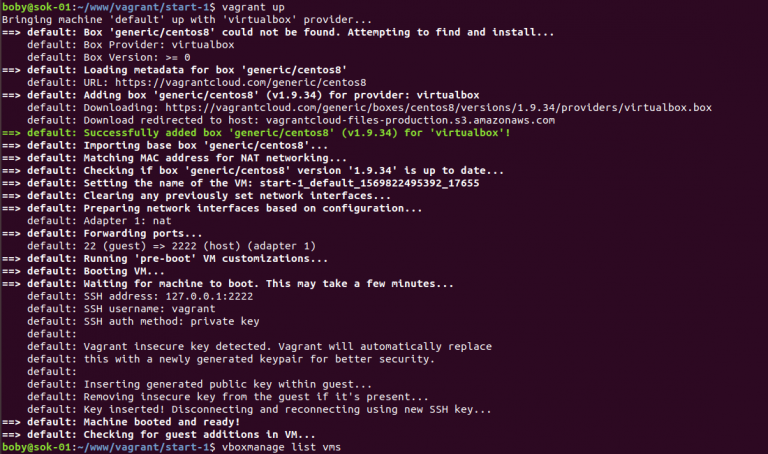

- Vagrant centos how to#
- Vagrant centos install#
- Vagrant centos trial#
- Vagrant centos license#
- Vagrant centos download#
Under Printer, click Remove Printer Port, and click Remove.Under USB & Bluetooth, expand Advanced USB options, click Remove USB Controller, and click Remove.Under Sound Card, click Remove Sound Card.Under CD/DVD, expand Advanced options, and change the Bus type to IDE.Under Hard Disk (SCSI), set the Disk size to 40.00 GB, expand Advanced options and uncheck Split into 2 GB files, then click Apply.Under Network Adapter, make sure Share with my Mac is selected.Under Display, turn Accelerate 3D Graphics Off.Under Processors & Memory, set Processors to 1, Memory to 512 (Vagrant can change these values later), expand Advanced options and check Enable hypervisor applications in this virtual machine.Under Sharing, turn Shared Folders Off.Save your virtual machine with what name you like, I chose centos-6.5-x86_64.vmwarevm, and click Save.
Vagrant centos install#
Uncheck Easy Install and click Continue.Choose the downloaded CentOS-6.5-x86_64-bin-DVD1.iso, click Open, and click Continue.Click Install from disc or image and click Continue.They may differ if you are using VMware Fusion 5. The following steps were written for VMware Fusion 6. An error message will be thrown if there is something wrong. Verify everything is working by running any of the Vagrant commands.
Vagrant centos license#
License the provider with the following command (save the license in a safe place, Vagrant will copy the license to it’s own directory as well): vagrant plugin license vagrant-vmware-fusion ~/Downloads/license.lic HashiCorp should have emailed you the Vagrant VMware Fusion Provider License by now.
Vagrant centos download#
Once Vagrant is installed, open the Terminal application and download and install the Vagrant VMware Fusion Provider plugin: vagrant plugin install vagrant-vmware-fusion This provider license is what allows Vagrant to talk to VMware Fusion. In addition, you will need to purchase the Vagrant VMware Provider License from HashiCorp, the creators of Vagrant, for $79.00 here. Next, download and install the latest version of Vagrant for OS X. Install Vagrant and the Vagrant VMware Provider License

Vagrant centos trial#
Install VMware Fusion 5 or 6īefore you begin, you will need to download and install a licensed copy of VMware Fusion 5 or 6 which costs $59.99 (there is a 30 day free trial available).
Vagrant centos how to#
If you prefer VirtualBox to VMware Fusion, read how to create a CentOS 6.5 Vagrant Base Box from scratch using VirtualBox. This post will walk you through creating a CentOS 6.5 Vagrant Base Box from scratch using VMware Fusion 5 or 6. However, I prefer to know exactly how my virtual machine image is created. There are many Vagrant Boxes available to use immediately after downloading and installing Vagrant. Please note, to execute vagrant ssh, you should be in the Vagrantfile directory.Vagrant makes it super easy to spin-up local virtual machines using VirtualBox or VMware Fusion. But if you want to SSH directly to the VMs you need to do a few more steps. If you wish you use method 01, you can simply execute the command, vagrant ssh SSH directly into the VMs from anywhere in the local machine.You can choose the interface to connect to the internet. You will see all your VMs are initializing. Now to start the services, execute the command vagrant up from the Vagrantfile location. nfigure("2") do |config| config.vm.define "vm1" do |vm1| vm1.vm.box = "centos/7" vm1.vm.hostname = 'vm1' vm1.vm.box_url = "centos/7" vm1.vm.network "public_network", bridge: "en0: Wi-Fi (AirPort)", auto_config: false end config.vm.define "vm2" do |vm2| vm2.vm.box = "centos/7" vm2.vm.hostname = 'vm2' vm2.vm.box_url = "centos/7" vm2.vm.network "public_network", bridge: "en0: Wi-Fi (AirPort)", auto_config: false end end Step 02 - Start VMs nfigure("2") do |config| config.vm.define "vm1" do |vm1| vm1.vm.box = "centos/7" vm1.vm.hostname = 'vm1' vm1.vm.box_url = "centos/7" vm1.vm.network "public_network", bridge: "en0: Wi-Fi (AirPort)", auto_config: false end endīut if you want two VMs, you can add the below configuration. Next, open Vagrantfile and add the below configurations This configuration is for one VM.You are now ready to `vagrant up` your first virtual environment! Please read the comments in the Vagrantfile as well as documentation on `` for more information on using Vagrant. Vagrant init A `Vagrantfile` has been placed in this directory. Using this file, you can configure many VMs. Create a project folder and redirect to the folder in your terminal.Let’s get started Step 01 - Initiating project Like ansible, which is a configuration automation tool, Vagrant automates the infrastructure of your virtual machines by using a single file Vagrantfile. Vagrant is a virtual machine infrastructure automation tool.


 0 kommentar(er)
0 kommentar(er)
